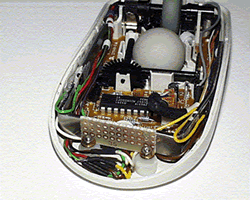
Measuring gripforce on the computer mouse
A. de Haan1, J. van de Ven2 and G.P. Galen3
1Human
Factors Research, NICI, University of Nijmegen, Nijmegen, The Netherlands
2Dutch IT Group / E&K Multimedia, Elburg, The Netherlands
3Experimental Psychology , NICI, University of Nijmegen, Nijmegen,
The Netherlands
During the performance of more demanding writing and pointing tasks, subjects exert more pen pressure towards the working [1]. This is a natural stiffness response to the noisier neuromotor signal in stressful conditions. Both physical and mental stress lead to such adaptive stiffness [3]. Higher stiffness, once the movement is initiated, can be achieved by speeding up the movement or by regulating the level of co-contraction of agonist and antagonist muscles. Acceleration is rather harmless and will only decrease the accuracy. Co-contraction can however be thought of as driving a car while applying the breaks. There is no return of the investment. Co-contraction also diminishes blood flow and thus the supply of nutrients and removal of carbon dioxide in the tissue. It could therefore lead to the beginning of RSI [2]. Being the most widely used input device for computers we designed a squeeze-mouse, sensitive to pressure applied to its sides to test the motor noise theory (NICI technical report 99-05) in the area of human-computer interaction. To measure grip forces, a steel construction, force receptors and an A/D measurement device were placed inside the mouse (Figure 1).
Calibration of the first prototype showed that no conversion of A/D-values to absolute force values could reliably be obtained. Within an experiment the baseline remained constant but was variable on longer time scales. Thus only within-experiment estimates could be obtained. In collaboration with the Hogeschool Enschede two main squeeze-mouse problems were identified. First, the characteristics of the mouse-material influence the measurements. Secondly, there is some type of noise in the signal that is hard to relate to any specific cause. Notwithstanding these problems the results of a first experiment with the mouse confirm the predictions made in the neuromotor noise theory [4].

Figure 1. Interior of squeeze-mouse
Poster presented at Measuring Behavior 2000, 3rd International Conference on Methods and Techniques in Behavioral Research, 15-18 August 2000, Nijmegen, The Netherlands